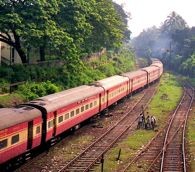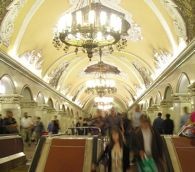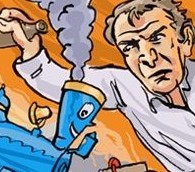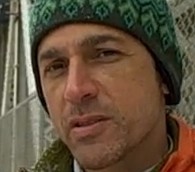Tag: Train Travel
Crawling Toward Bangalore
by Clay Shivers | 01.22.13 | 11:10 AM ET
Clay Shivers boarded the Indian train determined to live out his travel fantasies
Subterranean Gulag Baroque
by Taras Grescoe | 07.20.12 | 10:23 AM ET
In an excerpt from his new book, "Straphanger," Taras Grescoe explores Moscow's extraordinary Metro system
Wired: Public Transit is a ‘Civil Rights Issue’
by Eva Holland | 07.27.11 | 10:54 AM ET
Over at Autopia, Jason Kambitsis breaks it down:
[A]ccess to transportation is key to connecting the poor, seniors and those with disabilities to jobs, schools, health care and other resources. It is essential to widening opportunities for all. Many of us take our mobility for granted, but getting around can be a real challenge for millions of Americans… According to the [Leadership Conference on Civil and Human Rights] report, the average cost of owning a car is just shy of $9,500. That may not sound like much until you realize the federal poverty level is $22,350 for a family of four. One-third of low-income African-American households do not have access to an automobile. That figure is 25 percent among low-income Latino families and 12.1 percent for whites.
We’ve been keeping tabs on a variety of proposed high-speed rail plans over the years. The Autopia piece offers an important reminder that less-flashy investments in public transportation—from buses to bike lanes to more pedestrian-friendly streets—shouldn’t be forgotten, either.
‘Try to Think of a World Before the Railway’
by Michael Yessis | 01.06.11 | 1:36 PM ET
Imagine “the meaning of distance and the impediment it imposed when the time it took to travel from, for example, Paris to Rome—and the means employed to do so—had changed little for two millennia,” writes the late Tony Judt in a terrific two-part piece in the New York Review of Books.
Above all, think of how different the world looked to men and women before the coming of the railways. In part this was a function of restricted perception. Until 1830, few people knew what unfamiliar landscapes, distant towns, or foreign lands looked like because they had no opportunity or reason to visit them. But in part, too, the world before the railways appeared so very different from what came afterward and from what we know today because the railways did more than just facilitate travel and thereby change the way the world was seen and depicted. They transformed the very landscape itself.
Not to mention train travel’s impact on literature.
Retracing Paul Theroux’s ‘The Old Patagonian Express’
by Jim Benning | 11.04.10 | 2:10 PM ET
My favorite Paul Theroux book is The Old Patagonian Express, in which he chronicled his journey by train through the Americas. Theroux had a grand time, enduring irritating travelers, witnessing a soccer riot in El Salvador and reading to the late blind Argentine writer Jorge Luis Borges.
So I was happy to hear the other day from Rachel Pook, who is retracing the route Theroux followed in the book—at least from Costa Rica southward—and blogging about it.
As she explains on her site:
An urge for adventure teamed with huge admiration for Paul Theroux’s travel writing has led me to this project.
After seven years working at News International for The Times I decided to escape the confines of Fortress Wapping and do some exploring.
She embarked on the trip in August. Her last post, on Sunday, titled Altitude Sickness and a Tortoise, was from Peru.
93 Years of the New York Subway, in Photos
by Eva Holland | 10.25.10 | 11:46 AM ET
The New York Times compliled a gorgeous slideshow that spans from 1917 to the present. (Via Kottke)
Riding The Little Engine That Could
by Jim Benning | 09.17.10 | 10:16 AM ET
What if travel writer Paul Theroux had been aboard the train journey that became a classic children's book? Jim Benning imagines the account.
Literature’s Best Train Trips
by Michael Yessis | 09.07.10 | 12:54 PM ET
The Guardian lists 10 of them, including ones in JK Rowling’s “Harry Potter and the Philosopher’s Stone,” Graham Greene’s “Stamboul Train” and Thomas Hardy’s “Midnight on the Great Western.” Of the latter, John Mullan writes:
Hardy’s poem is a vignette of Victorian public transport, preserved forever. By “the roof-lamp’s oily flame” a boy is seen half asleep in his third-class seat, his ticket stuck in his hat band, “Bewrapt past knowing to what he was going, / Or whence he came”.
(Via @nicholebernier)
World Travel Watch: Tube Strikes Looming in London, China’s Epic Traffic Jam and More
by Larry Habegger | 08.25.10 | 11:59 AM ET
Larry Habegger rounds up global travel news
‘Crime and Punishment’ on the Moscow Subway
by Eva Holland | 08.10.10 | 3:17 PM ET
NPR explores the controversy surrounding one of Moscow’s famously decorated subway stations—Dostoevskaya, the station that honors Fyodor Dostoevsky. Apparently, some Russian psychologists are concerned that the darkness of the station’s artwork may inspire violence or suicide. David Greene sets the scene:
The walls are gray and bare, except for murals capturing scenes from Dostoevsky’s famous novels: Brothers Karamazov, The Idiot, and of course, Crime and Punishment, the book where Dostoevsky digs into the mind of his lead character, Raskolnikov, exploring a young man’s path to murder…
The fictional character—poor, desperate for money to help his family and mentally tortured—ends up killing two women. And it’s all depicted in a mural right on the subway platform in which Raskolnikov holds an ax over a woman’s head, while a corpse lies on the ground.
The tale itself is stirring, and the underground tunnel and echo of subway trains make it even creepier.
What’s Going on With the U.S.‘s ‘Global Joke’ of a Rail System?
by Michael Yessis | 08.03.10 | 2:10 PM ET
In his State of the Union address, President Barack Obama announced $8 billion in grants for high-speed rail. So where’s that money going and what progress has the country made on its much needed rail upgrade? Michael Grunwald investigates:
But while $8 billion is more than four times the annual federal subsidy for Amtrak, it is just one-eighth of last year’s federal spending on highways. And at a time when our national credit card is already maxed out, this down payment is only a tiny fraction of what’s needed to establish a competitive new mode of travel. China plans to invest more than $300 billion in high-speed rail by 2020, and Spain expects to complete a more than $200 billion system the same year in a country the size of Texas.
Meanwhile, the distribution of the Obama money—$3.5 billion to start new lines for bullet trains in Florida and California, plus $4.5 billion for sundry bridge and tunnel repairs, track straightening and other upgrades to existing Amtrak lines nationwide—has sparked intense debates even among rail advocates. Why spread cash around the country like peanut butter instead of targeting a few showcase projects? Shouldn’t the seed money go to game-changing new bullet routes rather than help for old Amtrak lines that bleed cash, share track with slow-moving freight and can never exceed 110 m.p.h.? Why not focus on Amtrak’s popular and profitable service between Boston and Washington, where Acela trains—now with wi-fi!—already reach speeds of 150 m.p.h. but average only half that? And how exactly does Ohio’s proposed 3-C corridor linking Cleveland, Columbus and Cincinnati at an average speed of only 39 m.p.h. and a top speed of 79 m.p.h.—first achieved by American trains 180 years ago—qualify as “high speed”?
‘It’s a Kind of Magic Place. You Go in One Door, You Go Out Another.’
by Michael Yessis | 07.06.10 | 11:56 AM ET
Those are the words of 11-year-old Adrien Venturi, an aficionado of the Paris Metro. He’s one of the sources for NPR’s lovely look at the system. “To ride it,” says Jacki Lyden, “is a visual carnival, a living history, an urban love story about the chemin de fer.”
Paris and London: Has Eurostar Made Them ‘Twins’?
by Eva Holland | 06.30.10 | 10:08 AM ET
Simon Kuper makes the case in a Financial Times essay that chronicles the changing relationship between the two cities over the years. Here’s Kuper on the dawn of Eurostar:
Those first trains connected two fairly insular cities. I had returned to Britain from Boston the summer before the Eurostar was launched, and after the Technicolor US, I was shocked by dingy London. Tired people in grey clothes waited eternities on packed platforms for 1950s Tube trains. Coffee was an exotic drink that barely existed, like ambrosia. Having a meal outside was illegal. The city centre was uninhabited, and closed at 11pm anyway. Air travel was heavily regulated, and so flying to Paris was expensive. Going by ferry took a whole miserable day. If you did get across, and only spoke the bad French most of us learnt at school, it was hard to communicate with any natives.
And then both cities began to change.
World Travel Watch: Floods in China, Train to Machu Picchu Resumes and More
by Larry Habegger | 06.23.10 | 12:07 PM ET
Larry Habegger rounds up global travel news
World Travel Watch: New Warnings for Mexico, Golf in Cuba and More
by Larry Habegger | 05.12.10 | 10:50 AM ET
Larry Habegger rounds up global travel news
How to Travel Like Kim Jong Il
by Michael Yessis | 05.05.10 | 3:21 PM ET
First, no jets. Use a train. Or three. You need the decoys. It’s not paranoia. People really would like to see you dead. Maybe travel at night, too, to avoid surveillance. Oh, and you’ll need food and drink. Send for a few cases of Bordeaux from Paris. It’ll go well with the live lobster you’ve shipped in.
The Los Angeles Times has more on how the Dear Leader likes to get around.
‘Traincation’? Oh No They Didn’t.
by Eva Holland | 04.28.10 | 2:21 PM ET
The Guardian goes there. Myself, I’d prefer any of the perfectly functional terms we already have for this practice: “train travel,” “train ride,” “taking the train” or even “a voyage by rail.”
76-Second Travel Show: ‘What a Hobo Knows’
by Robert Reid | 04.28.10 | 1:39 PM ET
Robert Reid collects travel tips and wisdom at a hobo gathering in Mississippi
Interview with Seth Stevenson: ‘Grounded’
by Frank Bures | 04.08.10 | 10:18 AM ET
The author's new book chronicles his surface journey around the world. Frank Bures asks him about it -- and why he thinks air travel isn't really travel.
World Travel Watch: Airplane Safety in Peru, Metro Bombings in Moscow and More
by Larry Habegger | 03.31.10 | 10:50 AM ET
Larry Habegger rounds up global travel news
- « Prev Page
- Next Page »






